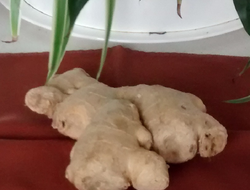Ginger and health benefits
Published: May 31, 2019
Ginger, Zingiber officinale, belongs to the Zingberaceae family which also includes turmeric and cardomon.
This flowering herbaceous perennial originated in South-east Asia and has spread though Asia, Indo-Pacific and to Hawaii.
It is the rhizome, or root, of the plant that is of both culinary and medicinal interest.
Mature rhizomes tend to be dry and fibrous whereas young rhizomes are generally fleshy and juicy with a mild taste.
Ginger’s many varied culinary uses have been tried and tested over generations.
However, the many purported health benefits of ginger have yet to be supported by sound research despite studies implying that many health claims have been “proven”.
Culinary uses of ginger
Culinary use of ginger dates back to the 13th century and ginger has traditionally been used as a spice to flavour many different types of foods and beverages.
Ginger can be used fresh, dried, candied or crystallized and is an important addition in Asian and Caribbean dishes.
Leaves of the plant can also be used to flavour foods. Fresh ginger is usually peeled before use and can be refrigerated or frozen for storage.
Culinary uses of ginger include:
- Main dishes such as curry and stir fries
- Soups
- Baked goods: gingerbread, cookies, crackers, cakes
- Preserves: jams, pickled in vinegar or sherry
- Confectionary: crystallized and candied
- Beverages: tea, coffee, ginger wine, ginger ale, ginger beer, yogurt drinks
Whether or not dietary ginger provides purported health benefits is unclear. Ginger is also available in the form of dietary supplements.
Nutrient content
As with most plant foods the major macronutrient of ginger rhizomes is water followed by carbohydrate (glucose, fructose, and sucrose and fibre).
Ginger rhizomes contain small amounts of protein and fat (saturated, and mono...link to the full article to learn more.

